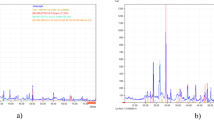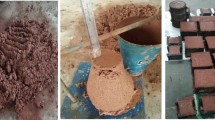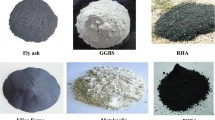Abstract
Fly ash and granulated blast-furnace slag can be considered "multifunctional waste." This study is focused on properties of a non-cement binder prepared from slag and fly ash activated by solid alkali activator. Fly ash was milled (2.5, 5.0, and 7.5 min) in order to increase its reactivity, and particle size distribution, specific surface area, and grain morphology were determined for all milled FA samples. Two GBFS + FA mixtures (70:30 and 85:15 w/w) were studied. Prepared mixtures were activated by solid alkali activator (Na2SiO3). Optimal weight ratios were calculated for CaO, SiO2, and Al2O3 components. Properties of the mixtures were studied in dependence on the GBFS:FA mass ratio and FA milling time (0–7.5 min). After 2 and 28 days of hydration, compressive strength of all mixtures exceeded 20 and 60 MPa, respectively. The 85:15 ratio led to generally higher compressive strength 108.3 MPa was reached after 90 days using FA milled for 7.5 min. Corrosion resistance was tested by exposing mixtures to distilled water, 0.5% HCl, and 3% Na2SO4 for 65 days, and evaluated by measuring changes in CS. Also the corrosion resistance was found higher (Na2SO4) than and comparable (HCl, water) to the 70:30 ratio. This study aims to show that GBFS + FA mixtures (70:30 and 85:15 w/w) activated by solid Na2SiO3 can achieve high CS and good corrosion resistance.
Graphical Abstract










Similar content being viewed by others
Abbreviations
- AA:
-
Alkali activator
- AAM:
-
Alkali-activated material
- AAS:
-
Alkali-activated slag
- BD:
-
Bulk density
- BET:
-
Brunauer–Emmett–Teller
- BFS:
-
Blast-furnace slag
- CS:
-
Compressive strength
- DoH:
-
Days of hydration
- FA:
-
Fly ash
- GBFS:
-
Granulated blast-furnace slag
- GPC:
-
Geopolymer Portland cement
- PC:
-
Portland cement
- SAA:
-
Solid alkali activator
- SEM:
-
Scanning electron microscopy
- SSA:
-
Specific surface area
- XRFS:
-
X-ray fluorescence spectroscopy
- XRPD:
-
X-ray powder diffraction
References
Hassan A, Arif M, Shariq M (2019) Use of geopolymer concrete for a cleaner and sustainable environment—a review of mechanical properties and microstructure. J Clean Prod 223:704–728. https://doi.org/10.1016/j.jclepro.2019.03.051
Yang B, Jang JG (2020) Environmentally benign production of one-part alkali-activated slag with calcined oyster shell as an activator. Constr Build Mater 257(2):119552. https://doi.org/10.1016/j.conbuildmat.2020.119552
Luukkonen T, Abdollahnejad Z, Yliniemi Y, Kinnunen P, Illikainen M (2014) One-part alkali-activated materials: a review. Cem Concr Res 103:21–34. https://doi.org/10.1016/j.cemconres.2017.10.001
Ismail I, Bernal AS, Provis JL, Nicolas SR, Hamdan S, Van Deventer JSJ (2014) Modification of phase evolution in alkali-activated blast furnace slag by the incorporation of fly ash. Cem Concr Compos 45:125–135. https://doi.org/10.1016/j.cemconcomp.2013.09.006
Davidovits J (2020) Geopolymer chemistry and applications, 5th edn. Institut Géopolymère, Saint-Quentin
Luukkonen T, Abdollahnejad Z, Yliniemi J, Kinnunen P, Illikainen M (2018) Comparison of alkali and silica sources in one-part alkali-activated blast furnace slag mortar. J Clean Prod 187:171–179. https://doi.org/10.1016/j.jclepro.2018.03.202
Pacheco-Torgal F, Castro-Gomes J, Jalali S (2008) Alkali-activated binders: a review: Part 1. Historical background, terminology, reaction mechanisms and hydration products. Constr Build Mater 22(7):1305–1314. https://doi.org/10.1016/j.conbuildmat.2007.10.015
Hajimohammadi A, van Deventer JSJ (2017) Characterisation of one-part geopolymer binders made from fly ash. Waste Biomass Valoriz 8:225–233. https://doi.org/10.1007/s12649-016-9582-5
Palomo A, Krivenko PV, Garcia-Lodeiro L, Kavalerova E, Maltseva O, Fernández-Jiménez A (2014) A review on alkaline activation: new analytical perspectives. Mater Construct. https://doi.org/10.3989/mc.2014.00314
Wang A, Zheng Y, Zhang Z, Liu K, Li Y, Shi L, Sun D (2020) The durability of alkali-activated materials in comparison with ordinary Portland cements and concretes: a review. Engineering 6(6):695–706. https://doi.org/10.1016/j.eng.2019.08.019
Vlček J, Švrčinová R, Burda J, Topinková M, Klárová M, Ovčačíková H, Jančar D, Velička M (2016) Hydraulic properties of ladle slag. Metalurgija 55(3):399–402
Komljenović M, Baščarević Z, Bradić V (2010) Mechanical and microstructural properties of alkali-activated fly ash geopolymers. J Hazard Mater 181(1–3):35–42. https://doi.org/10.1016/j.jhazmat.2010.04.064
ASTM C618-19, Standard specification for coal fly ash and raw or calcined natural pozzolan for use in concrete, ASTM International, West Conshohocken, PA, (2019)
Vargas AS, Molin DC, Vilelac ACF, da Silva FJ, Pavão B, Veit H (2011) The effects of Na2O/SiO2 molar ratio, curing temperature and age on compressive strength, morphology and microstructure of alkali-activated fly ash-based geopolymers. Cem Concr Compos 33(6):653–660. https://doi.org/10.1016/j.cemconcomp.2011.03.006
Komljenović M, Baščarević Z, Marjanović N, Miladinović Z, Petrović R (2015) The influence of fly ash characteristics and reaction conditions on strength and structure of geopolymers. Constr Build Mater 94:361–370. https://doi.org/10.1016/j.conbuildmat.2015.07.014
Kumar R, Kumar S, Mehrotra SP (2007) Towards sustainable solutions for fly ash through mechanical activation. Resour Conserv Recycl 52:157–159. https://doi.org/10.1016/j.resconrec.2007.06.007
Chu YS, Davaabal B, Kim DS, Seo SK, Kim Y, Ruescher C, Temuujin J (2019) Reactivity of fly ashes milled in different milling devices. Rev Adv Mater Sci 58:179–188. https://doi.org/10.1515/rams-2019-0028
Ononiwu NH, Ozoegwu CG, Akinribide OJ, Akinlabi ET (2021) Effect of particle size on the microstructure and distribution of fly ash for metal matrix composite applications. Mater Today Proc 44(1):1118–1123. https://doi.org/10.1016/j.matpr.2020.11.227
Felekoğlu B, Türkel S, Kalyoncu H (2009) Optimization of fineness to maximize the strength activity of high-calcium ground fly ash—Portland cement composites. Constr Build Mater 23:2053–2061. https://doi.org/10.1016/j.conbuildmat.2008.08.024
Petrakis E, Karmali V, Bartzas G, Komnitsas K (2019) Grinding kinetics of slag and effect of final particle size on the compressive strength of alkali activated materials. Minerals 9(11):714. https://doi.org/10.3390/min9110714
Zhang J, Shi C, Zhang Z, Ou Z (2017) Durability of alkali-activated materials in aggressive environments: a review on recent studies. Constr Build Mater 152:598–613. https://doi.org/10.1016/j.conbuildmat.2017.07.027
Chaparro WA, Ruiz JHB, de Jesús Torres Gómez R (2012) Corrosion of reinforcing bars embedded in alkali-activated slag concrete subjected to chloride attack. Mater Res 15(1):57–62. https://doi.org/10.1590/S1516-14392011005000096
Fernández-Jiménez A, Palomo A (2003) Characterisation of fly ashes. Potential React Alkaline Cem Fuel 82(18):2259–2265. https://doi.org/10.1016/S0016-2361(03)00194-7
Hossain MM, Karim MR, Hossain MK, Islam MN, Zain MFM (2015) Durability of mortar and concrete containing alkali-activated binder with pozzolans: a review. Constr Build Mater 93:95–109. https://doi.org/10.1016/j.conbuildmat.2015.05.094
Chi M, Huang R (2013) Binding mechanism and properties of alkali-activated fly ash/slag mortars. Constr Build Mater 40:291–298. https://doi.org/10.1016/j.conbuildmat.2012.11.003
Rashad AM (2014) A comprehensive overview about the influence of different admixtures and additives on the properties of alkali-activated fly ash. Mater Des 53:1005–1025. https://doi.org/10.1016/j.matdes.2013.07.074
European Norm EN 1927-5: Monolithic (unshaped) refractory products—Part 5: preparation and treatment of the test pieces, Czech Office for Standards, Metrology and Testing, Czech Republic, 2013
European Norm EN 196-6: Methods of testing cement—Part 6: determination of fineness, Czech Office for Standards, Metrology and Testing, Czech Republic, 2019
European Norm EN 196-1: Methods of testing cement. Part 1: determination of strength, Czech Office for Standards, Metrology and Testing, Czech Republic, 2016
European Norm EN 15167-1: Ground granulated blast furnace slag for use in concrete, mortar and grout-Part 1: definitions, specifications and conformity criteria, Czech Office for Standards, Metrology and Testing, Czech Republic, 2006
Duxson P, Provis JL (2008) Designing precursors for geopolymer cements. J Am Ceram Soc 91(12):3864–3869. https://doi.org/10.1111/j.1551-2916.2008.02787.x
Shi C, Roy D, Krivenko PV (2003) Alkali-activated cements and concretes, 1st edn. CRC Press, London
Temuujin J, Williams RP, Van Riessen A (2009) Effect of mechanical activation of fly ash on the properties of geopolymer cured at ambient temperature. J Mater Process Technol 209(12–13):5276–5280. https://doi.org/10.1016/j.jmatprotec.2009.03.016
Krivenko P (2017) Why alkaline activation—60 years of the theory and practice of alkali-activated materials. J Ceram Sci Technol 8(3):323–334. https://doi.org/10.4416/JCST2017-00042
White SC, Case ED (1990) Characterization of fly ash from coal-fired power plants. J Mater Sci 25:5215–5219. https://doi.org/10.1007/BF00580153
Paul KT, Satpathy SK, Manna I, Chakraborty KK, Nando GB (2007) Preparation and characterization of nanostructured materials from fly ash: a waste from thermal power stations, by high energy ball milling. Nanoscale Res Lett 2:397–404. https://doi.org/10.1007/s11671-007-9074-4
Chindaprasirt P, Jaturapitakkul C, Sinsiri T (2005) Effect of fly ash fineness on compressive strength and pore size of blended cement paste. Cem Concr Compos 27:425–428. https://doi.org/10.1016/j.cemconcomp.2004.07.003
Bapat JD (2012) Mineral admixtures in cement and concrete, 1st edn. CRC Press, Boca Raton
Fernández-Jiménez A, Garcia-Lodeiro I, Maltseva O, Palomo A (2019) Mechanical-chemical activation of coal fly ashes: an effective way for recycling and make cementitious materials. Front Mater 6:51. https://doi.org/10.3389/fmats.2019.00051
Hitesh, Wattal R, Surabhi L (2021) Development and characterization of coal fly ash through low-energy ball milling. Mater Today Proc 47(11):2970–2975. https://doi.org/10.1016/j.matpr.2021.05.204
Kanti P, Sharma KV, Ramachandra CG, Minea AA (2020) Effect of ball milling on the thermal conductivity and viscosity of Indian coal fly ash nanofluid. Heat Transf 49(8):4475–4490. https://doi.org/10.1002/htj.21836
Fernández-Jiménez A, Palomo A, Criado M (2005) Microstructure development of alkali-activated fly ash cement: a descriptive model. Cem Concr Res 35(6):1204–1209. https://doi.org/10.3989/mc.2006.v56.i281.92
Huseien GF, Mohd Sam AR, Alyousef R (2020) Texture, morphology and strength performance of self-compacting alkali-activated concrete: role of fly ash as GBFS replacement. Constr Build Mater 270:121368. https://doi.org/10.1016/j.conbuildmat.2020.121368
Huseien GF, Mirza J, Ismail M, Hussin MW (2016) Influence of different curing temperatures and alkali activators on properties of GBFS geopolymer mortars containing fly ash and palm-oil fuel ash. Constr Build Mater 125:1229–1240. https://doi.org/10.1016/j.conbuildmat.2016.08.153
Huseien GF, Tahir MM, Mirza J, Ismail M, Shah KW, Asaad MA (2018) Effects of POFA replaced with FA on durability properties of GBFS included alkali activated mortars. Constr Build Mater 175:174–186. https://doi.org/10.1016/j.conbuildmat.2018.04.166
Puligilla S, Mondal P (2013) Role of slag in microstructural development and hardening of fly ash-slag geopolymer. Cem Concr Res 43:70–80. https://doi.org/10.1016/j.cemconres.2012.10.004
Kubba Z, Huseien GF, Sam ARM, Shah KW, Asaad MA, Ismail M, Tahir MM, Mirza J (2018) Impact of curing temperatures and alkaline activators on compressive strengthand porosity of ternary blended geopolymer mortars. Case Stud Constr Mater 9:e00205. https://doi.org/10.1016/j.cscm.2018.e00205
Kumar S, Kumar R, Mehrotra SP (2010) Influence of granulated blast furnace slag on the reaction, structure and properties of fly ash based geopolymer. J Mater Sci 45(3):607–615. https://doi.org/10.1007/s10853-009-3934-5
Hany E, Fouad N, Abdel-Wahab M, Sadek E (2020) Compressive strength of mortars incorporating alkali-activated materials as partial or full replacement of cement. Constr Build Mater 261:120518. https://doi.org/10.1016/j.conbuildmat.2020.120518
Oderji SY, Chen B, Ahmad MR, Shah SFA (2009) Fresh and hardened properties of one-part fly ash-based geopolymer binders cured at room temperature: effect of slag and alkali activators. J Clean Prod 225:1–10. https://doi.org/10.1016/j.jclepro.2019.03.290
Kumar S, Kumar R, Bandopadhyay A, Alex TC, Kumar BR, Das SK, Mehrotra SP (2008) Mechanical activation of granulated blast furnace slag and its effect on the properties and structure of portland slag cement. Cem Concr Compos 30:679–685. https://doi.org/10.1016/j.cemconcomp.2008.05.005
Alrefaei Y, Wang YS, Dai JG (2021) Effect of mixing method on the performance of alkali-activated fly ash/slag pastes along with polycarboxylate admixture. Cem Concr Compos 117:103917. https://doi.org/10.1016/j.cemconcomp.2020.103917
Blanco F, Garcia MP, Ayla J, Mayoral G, Garcia MA (2006) The effect of mechanical and chemical activated fly ashes on mortar properties. Fuel 85:2018–2026. https://doi.org/10.1016/j.fuel.2006.03.031
Guo X, Shi H, Dick WA (2010) Compressive strength and microstructural characteristics of class C fly ash geopolymer. Cem Concr Compos 32(2):142–147. https://doi.org/10.1016/j.cemconcomp.2009.11.003
Yazdi MA, Liebscher M, Hempel S, Yang J, Mechtcherine V (2018) Correlation of microstructural and mechanical properties of geopolymers produced from fly ash and slag at room temperature. Constr Build Mater 191:330–341. https://doi.org/10.1016/j.conbuildmat.2018.10.037
Pangdaeng S, Phoo-ngernkham T, Sata V, Chindaprasirt P (2014) Influence of curing conditions on properties of high calcium fly ash geopolymer containing Portland cement as additive. Mater Des 53:269–274. https://doi.org/10.1016/j.matdes.2013.07.018
Angulo-Ramírez DE, Valencia-Saavedra WG, Mejía de Gutiérrez R (2020) Alkali-activated concretes based on fly ash and blast furnace slag: Compressive strength, water absorption and chloride permeability. Ingeniería e Investigación 40(2):72–80. https://doi.org/10.15446/ing.investig.v40n2.83893
Li H, Chen Y, Cao Y, Liu G, Li B (2015) Comparative study on the characteristics of ball-milled coal fly ash. J Therm Anal Calorim 124:839–846. https://doi.org/10.1007/s10973-015-5160-5
Kumar S, Bandopadhyay A, Rajinikanth V, Alex TC, Kumar R (2004) Improved processing of blended cement through mechanical activation. J Mater Sci 39:3449–3452. https://doi.org/10.1023/B:JMSC.0000026948.85440.cc
Puertas F, de Gutiérrez R, Fernández-Jiménez A, Delvasto S, Maldonado J (2002) Alkaline cement mortars. Chemical resistance to sulfate and seawater attack. Mater Constr 52(267):55–71. https://doi.org/10.3989/mc.2002.v52.i267.326
Rodríguez E, Bernal S, de Gutiérrez RM, Puertas F (2008) Alternative concrete based on alkali-activated slag. Mater Constr 58(291):53–67. https://doi.org/10.3989/mc.2008.v58.i291.104
Bakharev T, Sanjayana JG, Chengb YB (2002) Sulfate attack on alkali-activated slag concrete. Cem Concr Res 32:211–216. https://doi.org/10.1016/S0008-8846(01)00659-7
Tang XY, Xiao J, Chen F (2006) Effect and research progress of acid deposition on concrete durability. Mater Rev 20(10):97–101. https://doi.org/10.1016/j.eng.2019.08.019
Bernal SA, Rodriguez ED, de Gutierrez RM, Provis JL (2012) Performance of alkali-activated slag mortars exposed to acids. J Adv Cem Based Mater 1(3):138–151. https://doi.org/10.1080/21650373.2012.747235
Wang KT, Du LQ, Lv XS, He Y, Cui XM (2017) Preparation of drying powder inorganic polymer cement based on alkali-activated slag technology. Powder Technol 312:204–209. https://doi.org/10.1016/j.powtec.2017.02.036
Funding
This work was supported by Ministry of Education, Youth and Sports of the Czech Republic via the “Institute of Environmental Technology—Excellent Research” project [Grant Number CZ.02.1.01/0.0/0.0/16_019/0000853]; the “Research on the management of waste, materials and other products of metallurgy and related sectors” project [Grant Number CZ.02.1.01/0.0/0.0/17_049/0008426]; and the SGS projects [Grant Numbers SP2022/13 and SP2022/68].
Author information
Authors and Affiliations
Corresponding author
Ethics declarations
Conflict of interest
The authors declare that there is no conflict of interest.
Additional information
The contributing editor for this article was João António Labrincha Batista.
Publisher's Note
Springer Nature remains neutral with regard to jurisdictional claims in published maps and institutional affiliations.
Supplementary Information
Below is the link to the electronic supplementary material.
Rights and permissions
Springer Nature or its licensor (e.g. a society or other partner) holds exclusive rights to this article under a publishing agreement with the author(s) or other rightsholder(s); author self-archiving of the accepted manuscript version of this article is solely governed by the terms of such publishing agreement and applicable law.
About this article
Cite this article
Ovčačíková, H., Tokarský, J., Maierová, P. et al. Effect of Mass Ratio and Milling on Compressive Strength and Corrosion Resistance of Blast-Furnace Slag/Fly Ash Geopolymer Activated by Solid Alkali Activator. J. Sustain. Metall. 8, 1961–1974 (2022). https://doi.org/10.1007/s40831-022-00618-5
Received:
Accepted:
Published:
Issue Date:
DOI: https://doi.org/10.1007/s40831-022-00618-5




